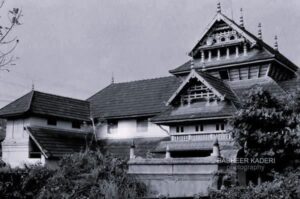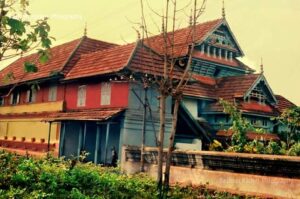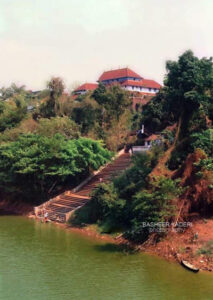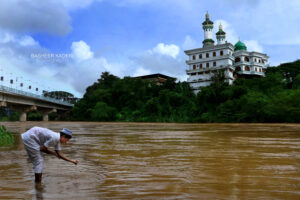In light of a lack of conventional historical sources, Sadik weaves a cultural and Islamic history of Tirurangadi using available archival materials and oral narratives from his fieldwork.
Mohammad Sadik K

One day, the world traveler Ibn Battuta got off at Tirurangadi on his way from Mannarkatt to Kozhikode. He entered the Valiya Jumu’ath Palli after cleansing himself, offered two rak’ahs, and attended the dars that was going on. He continued onward on his journey only after receiving blessings from the prayer. It is said that the mosque, tall and elegant and thatched with coconut leaves, was more than 600 years old when Battuta passed by.
Stories like this, still told by immammas (grandmothers) resonate throughout the historical alleys of Tirurangadi, offering us a glimpse into the place’s Islamic and cultural heritage. These stories may not be written down in history books or inscriptions, but they exist in the cultural memory of the people who have heard and witnessed these changes wash over the face of their town.

Situated in Malabar’s Malappuram district on the banks of the Kadalundi river, is Tirurangadi 1. It is a place that has played important roles at different junctures of Malabar’s history. Located on the borderlands of three Naduvazhi Swarupams 2–Nediyirippu, Valluvanadu, and Vettam, Tirurangadi’s physical location on the borders is often cited as a reason for its minor role in the geopolitical history of the region. However, this in no way makes the place any less important. Rather, my argument is that it is this very aspect that makes it offer a unique perspective towards understanding the history of Malabar. Like any other village in Kerala today, Tirurangadi is also undergoing rapid urbanisation and changes to its historical architecture. It is in this context of a sidelined history and a rapidly changing present that I set out to explore the history of the place.
There is a lack of reliable data from “conventional” historical sources, such as archaeological evidence and archival materials, that reveal the nuances of the region 3. Even though there are epigraphical sites nearby 4 , the inscriptions that have been discovered do not provide any information on the territory or people of Tirurangadi. In another instance, the residents of Pantharangadi had dug up a few burial urns or nannangadis, which are at present preserved by a local college, but they still await proper study. Similar is the case with megalithic burials that have been found near the Kadalundi river. Thus, in the absence of conventional historical data, writing the history of the place requires working with other sources that are often sidelined by mainstream history. In such a situation, oral histories and firsthand narratives allow us to create a unique historical tapestry of the place and its people. As I set out to document the Islamic cultural past of Tirurangadi, my research occupies a middle-ground, drawing from available historical sources as well as the lived experiences of the community of the town.
Snippets of an Incomplete History
Geopolitically, the location of Tirurangadi near the river made it a significant point for pre-colonial and colonial rulers. In AD 1745, the East India Company’s army marched from Kozhikode to Tirurangadi along with the Nair Pada of Zemorin with the aim of firing at Valiya Jumu’ath Palli. The two sides clashed in the Maidani (present-day Qabarstan) on the southern side of the mosque. The story goes that due to the resistance put up by the locals, the Company forces had to retreat in the middle of the night 5 . The graves of more than two hundred Muslims who were martyred that day were laid in the field. Tirurangadi was also a strategic location for Tipu Sultan who ruled Malabar from 1784 to 1792. The Battle of Tirurangadi comprised a sequence of military confrontations culminating towards the end of the year 1790, involving the British army and Tipu. Notably, Tirurangadi served as the backdrop for these engagements which ultimately marked the transition from Mysorean rule to the establishment of the British Raj at the close of 18th century CE (Logan 472-73).
The region also played a role in the literary and cultural history of Malabar. Printing emerged at the end of the nineteenth century, which had its impact in the Tirurangadi region also. These printing presses and publishing firms played a significant role in contributing to the literary culture of the place. Manbahul Ulum Press in Tirurangadi was the earliest initiative by Arayalpurat Pakki Thalasherry. From 1883, Amiral-Islam Litho Press of Chalilakattu Ahmad became an important center of Arabic-Malayalam publishing. This publishing house later became one of the most successful individual publishing houses in Malabar, producing hundreds of works in Arabic-Malayalam poetries and prose (Tanur 2015). Ahmad, who is known for reforming the Arabic-Malayalam script, also facilitated the printing of Arabic-Malayalam books. Some of these presses continue to function even today. One of their prominent publications is the Māla-Malwlid books 6. These books are seen in Muslim homes across Tirurangadi. This collection is affectionately referred to as ‘Sabeenah Kitab’ by the locals. During times of distress, such as the Nipah and Covid-19 viral outbreaks, families came together to recite the Sabeenah Kitab. This has become a cherished tradition, observed not only during difficult times but also in moments of joy.
These small facts of history hint at the idea that despite its marginal geographical location, Tirurangadi evolved as a place that contributed significantly to the history of Malabar–both politically and culturally. From here on, my focus is more specific to the role and relevance of the place for the spread of Islam in Kerala. In the processes of urbanization and development, what gets particularly lost is this history.
The Mosque–What Gets Lost, What is Gained
The story of Ibn Battuta’s visit with which I had begun this article hints at the rich tradition of Islamic history that Tirurangadi possesses.

Malabar bore witness to the arrival of early Islamic preachers in Kerala. They arrived along with the flourishing of trade relations between Arab and Malabari communities. They built mosques 7 in many places, and towns and communities grew along with these mosques. Tirurangadi was among the major towns that emerged in Malabar in this period (Makhdum 6-8). It is the popular belief that Islam reached Tirurangadi in the early days of its arrival in Kerala. They trace it back to Ponnani Makhdooms, a revered Sufi lineage in the town of Ponnani that led the renaissance of the Islamic community in Kerala five centuries ago. Tirurangadi inherited from Ponnani the Qadi tradition 8 that continues unbroken even after four centuries (Musliyar 1997). As the community grew, there also emerged scholars and leaders who governed their everyday social and religious matters, and all of this centered around the mosque.

The Valiya Jumu’ath Palli in Tirurangadi was one of the mosques built in the early years of Islam in Malabar. It is belived that this mosque was established in 83 AH 9.The tale of Battuta reveals that the mosque had a thatched roof during his visit. Historian Nellikuth Muhammadali Musliyar says that Thirurangdi Valiya Jumu’ath Palli was tile-roofed about 365 years ago (1997) 10. However, further details of the mosque’s early architecture have not been found anywhere till date.
Most of the early mosques in Kerala were constructed in alignment with the region’s architectural tradition. These mosques are known for their simplicity–featuring tiled roofs, spacious prayer halls surrounded by verandas, tall foundations, and walls built from laterite blocks. Much like Hindu temples, wood plays a significant role in their architecture. This is seen in mosques like Cheraman Jumu’ath Masjid, Kuttichira Valiya Jumuath Masjid, and Mishkal Mosque. The architectural styles of the earlier mosques in Kerala and their resemblance to Hindu temple architecture can be attributed to a syncretic approach shaped by historical trade connections, cultural exchanges, and a desire for a distinct community identity. The architectural specificities of mosques should be considered crucial material for studies of history.

However, since the second half of the 20th century, some of these mosques have been renovated and transformed into Gulf-style mosques. This style is characterized by modern and futuristic designs, featuring sleek lines and glass facades. Dominated by tall skyscrapers, these structures often incorporate Islamic geometric patterns, providing a cultural touch. Unfortunately, the complete demolition of old wooden structures, without any attempt at preserving their history, is now widespread in most parts of Malabar. It stems from a notion that the traditional architectural model of wooden mosques is outdated and that the style from West Asia bears the true Islamic tradition. The growth in the number of community members and the high cost of maintaining such wooden structures force mosques toward reconstruction. While the community appreciates the history of these shrines and their legendary or real founders, they do not attach that much importance to the actual structure in light of practical difficulties. It does not receive any consideration beyond that of a regular building made of lime mortar, wooden beams, and building debris. Besides, in the hot and humid climate of Malabar, wooden structures generally struggle to have a long lifespan, thus making their maintenance expensive. So in many cases it is considered more practical to build new mosques than to keep the old.
The Valiya Jumu’ath Palli in Tirurangadi, where the Odakal Makhdooms served as Qadis, is an example of this very cultural transition 11. Unfortunately, the old mosque received no protection from the government or local authorities. Consequently, the Mahallu Committee 12, disregarding the objections of many locals 13 demolished the Tirurangadi Mosque and reconstructed it as a Gulf Mosque in 2011. The reasons cited include the poor condition of the mosque since 2005, with people saying that they feared that the top floor would come crashing down on them! But unfortunately, for the researching historian, what got lost are the inscriptions that people say were part of the old mosque. If such inscriptions indeed existed, and what they were, thus still remain a question.
Mosques are an integral part of the history of Malabar’s Muslim community, and the Tirurangadi Juma Masjid is no exception. As towns grew around mosques, it became more than a religious place of worship, but an identity marker for the community and their history. In such a context, the inability to preserve the mosque denies us crucial insights into the history of an important cultural centre of early Malabar. It is essential to explore the architecture of the old Juma Masjid and the inscriptions within it. The same goes for other historically important architectural structures that are scattered all over Kerala. However, it is disheartening to note that these ancient structures are being dismantled without much thought about preservation.
Conclusion
Through these snippets of histories that are woven together in this article, I have tried to raise your curiosity towards the complex historical and cultural tapestry of Tirurangadi. Despite the absence of conventional historical data, Tirurangadi needs to be looked at seriously for the insights its histories hold in shaping our understanding of Malabar.
A focal point of the narrative is the Valiya Jumu’at Masjid, an early mosque with architectural significance. The marginal position of Tirurangadi in the pre-modern period was further aggravated by historians who did not pay sufficient attention to geopolitical regions that were not considered power centers. Protecting older structures along with preserving the fleeting and intangible cultural memory of the people are important so that the history of a place does not get lost in the processes of modernization.
References
- Ganesh, K N. Socio-cultural Processes and Livelihood Patterns at Tirurangadi: A Micro Historical Study. Thennipalam: Calicut University.
- Hussain Nainar, S. Muhammad. 1942. Tuhfat-al-Mujahidin: An Historical Work in The Arabic Language. Chennai: of Madras.
- Malayamma, Dr. Moyin. 2015, Cahlilakathinte Vidybasa Parishkaranam (Chalilakath’s Educational Reformation). Calicut: Islamic Sahithya Academy.
- Mandalamkunn, Zynudheen. 2015, Sayyid Sanullah Makthi Thangal: Mathaydasthikanum Samoohikaparishkarthavum. Calicut: Isalimic Sahihtya Academy.
- Makhdum, Sheikh Zainuddin. 2014. Tuhfat Ul Mujahidin. Delhi: National Mission of Manuscripts.
- Menon, M P S. 1992. Malabar Samaram: mp Narayana Menonum Sahapravathakarum, Sahapravathakarum, Angadipuram: Mp Narayana Menon Memmorial Committee.
- Miller, Roland E. 1976. Mappila Muslims of Kerala: Study in Islamic Trends. Madras: Orient Longman Limited.
- Mohammed Ali Bin Ubaidullah Moulavi Al Nellikuthi, 2022. Thuhafathul Akhyar Fi A’yani Malibar, Chemmad: Book Plus.
- Musliyar, Nellikuth Muhamadali, A P. 1997. Malayalathile Maharathanmar, Calicut: Markaz Complex.
- Naravane, M S. 2014. Battles of the Honorable East India Company. A.P.H. Publishing Corporation.
- Niyas Muhammed, 2021. “Entanglements of Arabic- Malayalam Print Culture and Trajectories of Muslim Intellectual spehre in the late nineteenth and early Twentienth Century Malabar”. Edited Volume by Babu Cheriyan. Kottayam: Sahithya Pravarthaka Co-operative Society Ltd.
- Logan, William. 2010. Malabar Manual (Volume-I). New Delhi: Asian Educational Services.
- Singh, Dr. Y. P. 2016. Islam in India and Pakistan. A Religious History, Delhi: Vij Books India Private Limited.
- Tanur, Sadiq Faizy. 2015. Matanaveekarana Vadathinte Tudakkam Makthi Thangalil Ninnalla. Calicut: Isalimic Sahihtya Academy.
About the Author: Mohammad Sadik is a first-year MA Civilizational Studies Scholar at Darul Huda Islamic University who is interested in studying history, the Malabar region, manuscripts and mosques. He is currently working as a sub-editor at Thelicham magazine.

Excellent article 👌
👍
Incredible